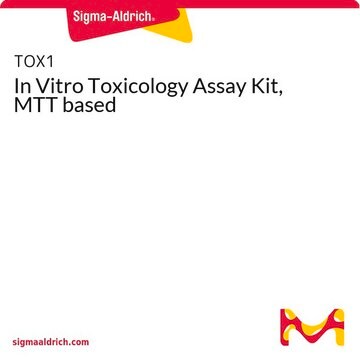X4626
XTT sodium salt
powder, BioReagent, suitable for cell culture
Synonyme(s) :
2,3-Bis(2-methoxy-4-nitro-5-sulfophenyl)-2H-tetrazolium-5-carboxanilide inner salt, 2,3-Bis(2-methoxy-4-nitro-5-sulfophenyl)-2H-tetrazolium-5-carboxanilide inner salt
Sélectionner une taille de conditionnement
309.00 CHF
Sélectionner une taille de conditionnement
About This Item
309.00 CHF
Produits recommandés
Gamme de produits
BioReagent
Niveau de qualité
Essai
≥90%
Forme
powder
Conditions de stockage
dry at room temperature
Technique(s)
cell culture | mammalian: suitable
protein quantification: suitable
Application(s)
detection
Méthode de détection
colorimetric
Température de stockage
2-8°C
Chaîne SMILES
[Na+].COc1cc(c(cc1-n2nc(n[n+]2-c3cc(c(cc3OC)[N+]([O-])=O)S([O-])(=O)=O)C(=O)Nc4ccccc4)S([O-])(=O)=O)[N+]([O-])=O
InChI
1S/C22H17N7O13S2.Na/c1-41-17-8-15(28(31)32)19(43(35,36)37)10-13(17)26-24-21(22(30)23-12-6-4-3-5-7-12)25-27(26)14-11-20(44(38,39)40)16(29(33)34)9-18(14)42-2;/h3-11H,1-2H3,(H2-,23,30,35,36,37,38,39,40);/q;+1/p-1
Clé InChI
JACYMBNQPPWQML-UHFFFAOYSA-M
Vous recherchez des produits similaires ? Visite Guide de comparaison des produits
Description générale
Application
Actions biochimiques/physiologiques
Principe
Produit(s) apparenté(s)
Mention d'avertissement
Danger
Mentions de danger
Conseils de prudence
Classification des risques
Self-react. C
Risques supp
Code de la classe de stockage
4.1A - Other explosive hazardous materials
Classe de danger pour l'eau (WGK)
WGK 3
Point d'éclair (°F)
Not applicable
Point d'éclair (°C)
Not applicable
Équipement de protection individuelle
Eyeshields, Gloves, type N95 (US)
Faites votre choix parmi les versions les plus récentes :
Certificats d'analyse (COA)
Vous ne trouvez pas la bonne version ?
Si vous avez besoin d'une version particulière, vous pouvez rechercher un certificat spécifique par le numéro de lot.
Déjà en possession de ce produit ?
Retrouvez la documentation relative aux produits que vous avez récemment achetés dans la Bibliothèque de documents.
Les clients ont également consulté
Active Filters
Notre équipe de scientifiques dispose d'une expérience dans tous les secteurs de la recherche, notamment en sciences de la vie, science des matériaux, synthèse chimique, chromatographie, analyse et dans de nombreux autres domaines..
Contacter notre Service technique













